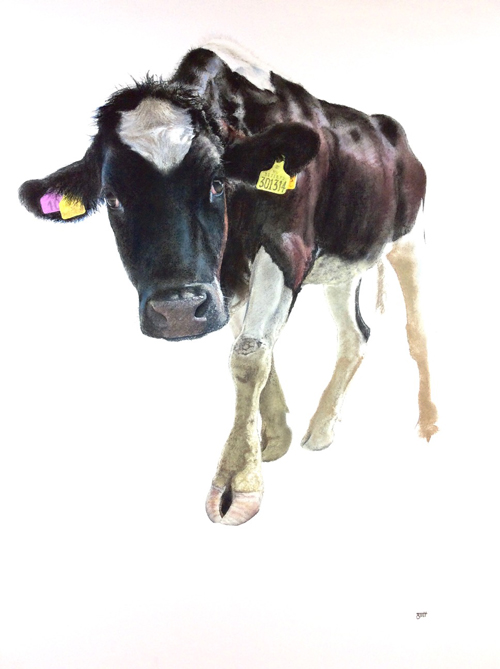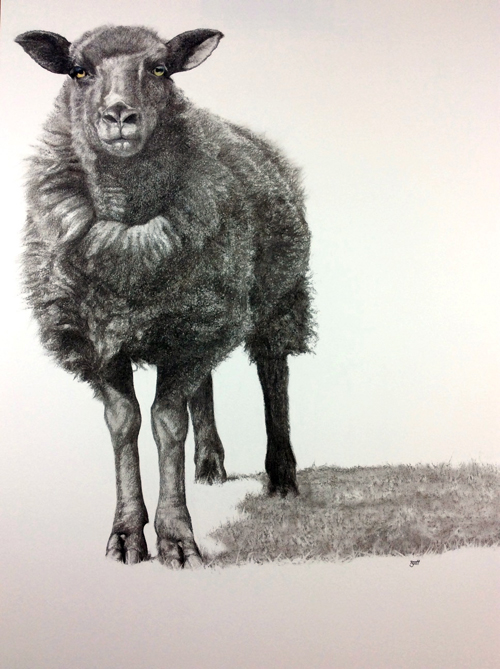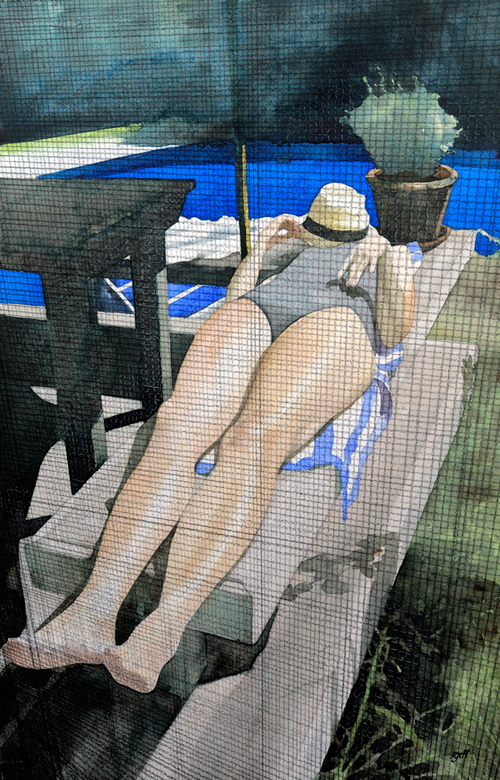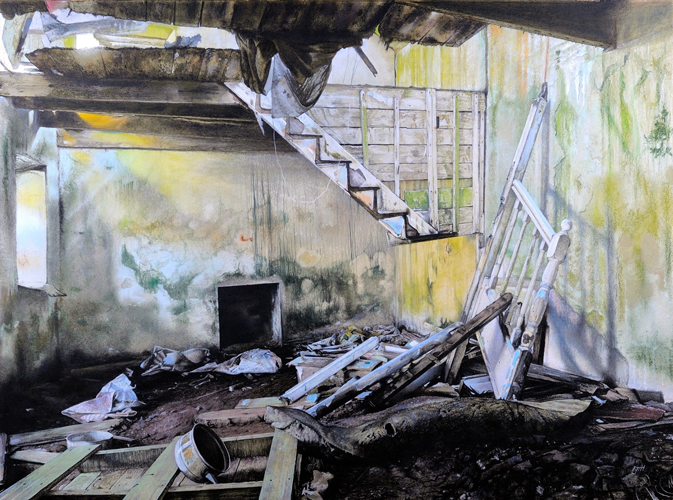Art, // May 1, 2021
RJT Haynes — ARTIST
Interview with artist RJT Haynes —
1. Who are you and what do you do?
RJT Haynes – Toby to my friends. I’m a visual artist based in the UK; for the last few years I’ve also spent quite a bit of time in the US – the bustle & culture of New York/Long Island are a contrast with my remote cottage in North Cornwall, where I sometimes don’t see another soul for weeks. I read German & Philosophy at Oxford in the days when you could still get away with that sort of thing, before moving to Cornwall. It was seventeen years before I got electricity here; the changing seasons and the quality of light are much more noticeable when the alternative is a candle or oil lamp – and there’s no point lighting those till it’s nearly dark. For several years I worked for the conservation charity The National Trust on real pick & shovel projects – in some of our most beautiful coastal & woodland areas, and in all weathers – until deciding to devote myself full-time to painting & writing.
2. Why art?
To a former philosophy student, becoming an artist seems a relatively pragmatic career move, and the preparation is as good as any other…
3. What is your earliest memory of wanting to be an artist?
My father was a signwriter (sign painter), and I grew up with the smell of paint & turpentine; I have early memories of climbing ladders & wobbly scaffolding to help with rooftop signs or the hand-painted graphics on heavy goods vehicles – Health & Safety would have been horrified. My brother & I invariably got new tins of watercolours at Christmas… It was probably inevitable that I’d become a painter (though my brother did not: he’s a book editor).
4. What are your favorite subject(s) and media?
I usually say my favourite medium is whichever one I’m working in at the moment, which could be oils, watercolour, charcoal, pastel, pencil, occasionally acrylics; if I really really had to choose just one, I’d say pastel. Or coloured pencils… I like the slow accretion of colour & layers with these media, the way they invite a closer look. That said, I’m doing oils at the moment and loving their tactile, sculptural qualities – even without heavy impasto – so ask me again tomorrow and the answer might be different. People sometimes mistake my solo shows for group shows because of the variety; when I work in series it’s often the first piece that’s the favourite – I may move on to something else and revisit the theme another time.
5. How do you work and approach your subject?
Recurrent themes include farm animals (most of my neighbours are cows or sheep, and my studio is next to grazing land on one side): they’re appealing subjects – at once familiar & unfamiliar to many people nowadays – and their ambivalent, edgy relationship with humans intrigues me; there are all sorts of patterns & textures in the dense coat of a sheep, for example, that blur any figurative/abstract distinction. I once read an article about a photographer of nudes; he said it was all about the light, and they could as easily be sacks of potatoes. Well okay – but there were no potatoes among his images. (Not sure what the models thought about his comment either.) Some paintings are mainly an exploration of form & colour for its own sake, but it’s grounded in what I actually see, so the subject is never wholly random. Accidental arrangements, such as abandoned things or places, can be wonderful, but painting them involves choices throughout.
6. What are your favorite art work(s), artist(s)?
I most admire the great craftsmen of painting such as Johannes Vermeer, John William Waterhouse, Andrew Wyeth, & Gerhard Richter. I’d better stop there or it’ll turn into an Oscar speech. It’s invidious. It just has to be something that interests me. ‘The Horse’s House’ is a good example; it’s a derelict house perched right on the edge of the Atlantic in Co. Kerry. They told me (and no Irishman would spin you a tale) the last tenant was a horse. I painted the exterior view plein air in oils during a winter residency, then worked on a larger, much more detailed interior in pastels & coloured pencil over watercolour washes; this took about two hundred hours. I’ve learnt that detail is not the same as reality, and long ago stopped using a size 000000 brush (which might as well be just the handle & ferrule anyway, for all the paint it can hold); but sometimes detail becomes the subject, at least in part. In this drawing wanted to convey the sense of time – of lives – past, the archaeological layers of obscure histories; I never believed that line of Carlyle’s: ‘the history of the world is but the biography of great men.’
7. What do you like about your work?
I’ve always loved the alchemy of line & colour, and hunting for the spark that makes all the difference to an image. Whatever the initial idea, a picture never turns out exactly as originally conceived, nor should it – it’s the journey that’s interesting, and discoveries made along the way. I will change my technique or the colours on my palette if it starts to feel too familiar & comfortable: the materials & subject have a say in what becomes of them, and painting is a form of negotiation or collaboration. I don’t want to get clever enough to have a recipe.
I’d be a poor taxonomist because I’m naturally wired to see similarities & connections rather than differences & distinctions: something as deceptively simple as an apple makes me think of the tree, the blossom, the pollinating insect, the harvest, cookery books, religious & erotic symbolism, &c. How this affects the final painting is impossible to pin down; still, all the ingredients are there even if they’re not immediately discernible. I’m not so much interested in fleeting impressions as in their lasting effects, the memory of them, the mycelial web of associations they send out – but a painting must ultimately have a life of its own, to find its way without exegesis: visual art should be intelligible visually. Most of all I want my work to find an emotional resonance with the viewer; when that happens it’s the best feeling.
8. What advice would you give to other artists?
Be your own honest critic; work on things that really engage you, not what’s trending on Instagram.
9. Where do you see yourself in 5-10 years?
My largest painting so far is a modest 36”x56”, mainly for reasons of storage & transportation; I’d like to work on a bigger scale, though it’s a daunting prospect to roll up a giant charcoal drawing and stuff it into a cardboard tube. I work in various styles & media that offer infinite scope for further exploration & development.
LINKS —
Website: http://tobyhaynes.com/
Contact: r.j.t.haynes@gmail.com
Instagram: RJT Haynes (@r.j.t.haynes)
Parrish Museum show: https://vimeo.com/190123077
East End Arts show: http://www.eastendarts.org/gallery/national-show-2017.html
Profile from The Artist’s Road: http://www.theartistsroad.net/articles/tobyhaynesprofile
New York Times: http://tobyhaynes.wpengine.com/wp-content/uploads/2014/05/New-York-Times-Sheepscape-copy1.jpeg












